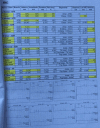Guillain-Barré syndrome following the second dose of COVID AstraZeneca vaccine in a 78-year-old male: a case report from Nepal
- PMID: 36923770
- PMCID: PMC10010811
- DOI: 10.1097/MS9.0000000000000193
Guillain-Barré syndrome following the second dose of COVID AstraZeneca vaccine in a 78-year-old male: a case report from Nepal
Abstract
Guillain-Barré syndrome (GBS) is a rare acute idiopathic demyelinating polyneuropathy that causes bilateral, symmetrical, and progressive weakness of muscles. AstraZeneca vaccine is a genetically modified spike glycoprotein vaccine of an adenovirus vector. GBS following the second dose of the AstraZeneca vaccine dose is rare and not frequently noted.
Case presentation: A 78-year-old male presented to the hospital with complaints of bilateral weakness of the lower limbs over 4 days following the second dose of the AstraZeneca vaccine. On examination, the power and tone of the limbs were diminished. The sensitivity pinprick test revealed low sensitivity in the right lower limb than in the left lower limb. Nerve conduction studies revealed acute inflammatory demyelinating polyneuropathy and the patient was diagnosed with GBS. After admission, the patient was successfully treated with intravenous immunoglobulins along with physiotherapy.
Clinical discussion: GBS can be diagnosed clinically with nerve conduction studies and Brighton's criteria. The robust causal relationships between COVID-19 infections, COVID-19 vaccination, and GBS are still unclear. The evaluation of the potential association and risk of GBS with vaccines warrants the need for precise post-vaccination surveillance measures and results.
Conclusion: Only a few cases of GBS following the second dose of AstraZeneca are reported so far and there is a need for strong and accurate diagnosis of the disease and proper post-vaccination surveillance for the evaluation of risk associated with COVID vaccines.
Keywords: AstraZeneca; Guillain-Barré syndrome; case report; post-COVID-19 vaccination.
Copyright © 2023 The Author(s). Published by Wolters Kluwer Health, Inc.
Conflict of interest statement
All authors declare that they have no any conflicts of interest.Sponsorships or competing interests that may be relevant to content are disclosed at the end of this article.
Figures
Similar articles
-
Acute-onset chronic inflammatory demyelinating polyneuropathy following AstraZeneca COVID-19 vaccine: a case report.Pan Afr Med J. 2024 Feb 6;47:46. doi: 10.11604/pamj.2024.47.46.42455. eCollection 2024. Pan Afr Med J. 2024. PMID: 38681104 Free PMC article.
-
AstraZeneca COVID-19 vaccine and Guillain- Barré Syndrome in Tasmania: A causal link?J Neuroimmunol. 2021 Nov 15;360:577719. doi: 10.1016/j.jneuroim.2021.577719. Epub 2021 Sep 17. J Neuroimmunol. 2021. PMID: 34560365 Free PMC article. Review.
-
COVID-19 vaccination and Guillain-Barré syndrome: analyses using the National Immunoglobulin Database.Brain. 2023 Feb 13;146(2):739-748. doi: 10.1093/brain/awac067. Brain. 2023. PMID: 35180300 Free PMC article.
-
Guillain-Barré syndrome temporally associated with COVID-19 vaccines in Victoria, Australia.Vaccine. 2022 Dec 12;40(52):7579-7585. doi: 10.1016/j.vaccine.2022.10.084. Epub 2022 Nov 7. Vaccine. 2022. PMID: 36357291 Free PMC article.
-
Guillain-Barre syndrome following COVID-19 vaccines: A review of literature.Front Immunol. 2023 Feb 15;14:1078197. doi: 10.3389/fimmu.2023.1078197. eCollection 2023. Front Immunol. 2023. PMID: 36875094 Free PMC article. Review.
Cited by
-
Pharmacovigilance in Vaccines: Importance, Main Aspects, Perspectives, and Challenges-A Narrative Review.Pharmaceuticals (Basel). 2024 Jun 19;17(6):807. doi: 10.3390/ph17060807. Pharmaceuticals (Basel). 2024. PMID: 38931474 Free PMC article. Review.
-
Guillain-Barre syndrome following COVID-19 vaccination: a study of 70 case reports.Ann Med Surg (Lond). 2024 Mar 6;86(4):2067-2080. doi: 10.1097/MS9.0000000000001915. eCollection 2024 Apr. Ann Med Surg (Lond). 2024. PMID: 38576928 Free PMC article. Review.
References
-
- Agha RA, Franchi T, Sohrabi C, et al. . The SCARE 2020 Guideline: Updating Consensus Surgical CAse REport (SCARE) Guidelines. Int J Surg 2020;84:226–230. - PubMed
-
- World Health Organization. Nepal: WHO Coronavirus Disease (COVID-19) dashboard with vaccination data. 2022. Accessed 25 September 2022. https://covid19.who.int/region/searo/country/np
-
- Maramattom BV, Krishnan P, Paul R, et al. . Guillain-Barré syndrome following ChAdOx1-S/nCoV-19 vaccine. Ann Neurol 2021;90:312–314. - PubMed
Publication types
LinkOut - more resources
Full Text Sources



